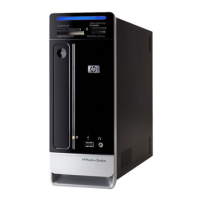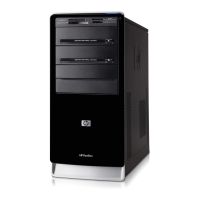18 Troubleshooting and Maintenance Guide
Power
Symptom Possible solution
Computer will not turn on
or start.
Ensure that cables connecting the computer to the external power source are
plugged in properly.
When the cables connecting the computer to the external power source are
plugged in properly, and the wall outlet is functioning, the green power supply
light on the back of the computer should be on; if it is not, refer to the Limited
Warranty and Support Guide to contact Support.
If the display (monitor) is blank, the monitor may not be properly connected.
Connect the monitor to the computer, plug it in, and turn it on. See “Display
(Monitor)” on page 10.
Set the line voltage selection switch to the correct setting for your
country/region, or refer to the Limited Warranty and Support Guide to
contact Support.
Test the wall outlet by connecting a different electrical device to it.
Incompatible memory (RAM) may have been installed. Reinstall the old
memory to return your computer to its original state. For instructions, refer to
the Upgrading and Servicing Guide.
Reseat the hard disk drive data and power cables. For instructions, refer to the
Upgrading and Servicing Guide.
Error message: Invalid system
disk or Non-System disk or
disk error.
When drive activity stops, remove the disk and press the spacebar on the
keyboard. The computer should start up.
Computer does not turn off
when the On button is
pressed.
Press and hold the On button until the computer turns off.
Computer shuts down
automatically.
The computer may be in an exceedingly hot environment. Let it cool down.
Ensure computer air vents are not blocked and internal fan is running. Note
that your computer may not have an internal fan.
Computer displays the wrong
date and time.
The real-time clock (RTC) battery may need to be replaced. Battery life is
approximately seven years.
Before replacing the battery, try resetting the date and time in your operating
system by using the Control Panel. If the problem persists, replace the battery.
For instructions, refer to the Upgrading and Servicing Guide.
Computer displays a
processor speed that is lower
than expected.
This happens when the processor is automatically running in a lower power
state, because the applications running do not require the maximum
processing power.
